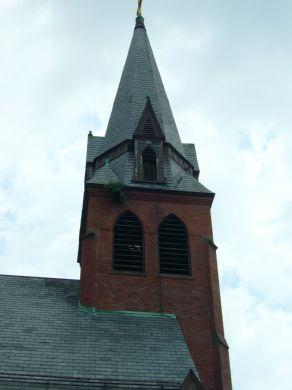Court Considers Jurisdiction, Other Matters in Mater Dolorosa Trespassing Hearing
By Terence Hegarty
SPRINGFIELD – Questions from Hampden Superior Court Judge C. J. Moriarty regarding whether the Diocese of Springfield has the jurisdiction to have protesters removed from a closed Holyoke church dominated a 2 p.m. court proceeding Jan. 4. However, Attorney John J. Egan, principal attorney for the diocese, argued before the judge that the case "has nothing to do with jurisdiction," and asked Judge Moriarty to consider the diocese (as a corporation sole) as he would any other property owner. In that context, Egan said, Moriarty should only consider "whether or not the defendants are trespassing." "The question is, whether, under civil law, there are any rights to ownership," Egan said. Following an hour of hearing arguments from both Egan and attorneys Victor Anop and Peter Stasz, representing the Friends of Mater Dolorosa, Judge Moriarty adjourned the hearing, declaring that he would take the arguments "under advisement." Early on in the hearing, Egan stated that a civil court cannot consider canon law. Judge Moriarty agreed on that point, but still stated that the "jurisdictional issue is the first issue that I have to get by." Egan countered that, since the judge cannot rule on church law, he must apply "neutral principles of law" when deciding the case. Attorneys Anop and Stasz have asked the court to consider canon law in the diocese's trespassing case, claiming both that the diocese does not have the authority to act as a corporation sole and that parishioners themselves constitute the diocese. "Canon law has everything to do with this," said Stasz as he addressed Moriarty. The Friends of Mater Dolorosa cited canon 1214 which states, in part, "the term church signifies a sacred building destined for divine worship to which the faithful have a right of access for divine worship." However, canon 515, paragraph 2 states, "the diocesan bishop alone is competent to erect, suppress or alter parishes." "This is a freedom of religion issue, and as long as parishioners have an appeal pending (at the Vatican), this court should step aside," Stasz said. Egan stated that the diocese disputes the fact that canon law can be considered as evidence in these hearings. This was the second hearing in the case, which the diocese originally filed last October. Last summer, two Holyoke parishes, Mater Dolorosa Parish and nearby Holy Cross Parish were merged by the diocese as part of the years-long, diocesan-wide pastoral planning process. Following the last Mass at Mater Dolorosa Church on Maple Street June 30, protesters occupied the building, holding vigil in the church. They have kept a 24-hour presence there since. The diocese has sought to resolve the matter and has argued previously that the century-old church needs to be cleared because the wooden steeple is damaged and therefore the church is unsafe for occupation. In October, the diocese filed suit, claiming that those holding vigil are trespassing. "Friends of Mater Dolorosa" filed a countersuit soon afterward. Television cameras and a handful of reporters joined the nearly 70 Mater Dolorosa supporters in the overflowing courtroom this January afternoon. Attorneys Anop and Stasz also contended in court that Springfield Bishop Timothy A. McDonnell was not within his rights to file the motion in October. They argued that the bishop failed to file paperwork with the state that is required of him as the head of a corporation sole in Massachusetts. The Diocese of Springfield operates as a corporation sole, as do most hierarchical church entities. This allows the diocese to legally own property and manage their funds. Egan admitted that the filing, which would normally have been completed when the bishop was appointed in 2004, was late. However, he pointed out to the judge that even though the paperwork was filed late in 2011, the Massachusetts Secretary of State certified Bishop McDonnell's appointment as of March of 2004, meaning that his authority is valid since his appointment. As counterclaims, Anop and Stasz also contend that both the federal and state civil rights of protesters have been violated. They also dispute that the formal notifications from the diocese that they are trespassing were properly delivered. Following the one-hour proceeding, Egan told iobserve that he felt the matter was not complicated. "We think it's clear. It doesn't make sense that churches can be trespassed upon," he said. "If you accept that premise, then churches have less rights than any other property owner." Egan said that both sides now must wait for a ruling, something he expected to take about a month. He said that the judge could rule on the motions and the case would be over, or he could send it to trial. "We think it (the case) should be concluded," he told iobserve, "and the occupiers should be enjoined from occupying the building." In an order issued after the Jan. 4 hearing, Judge Moriarty gave the Mater Dolorosa group 10 days to supplement their affadavits, and gave the diocese 10 days from the date of the group's filing to respond to it.
|
.
Any original material on these pages is copyright © BishopAccountability.org 2004. Reproduce freely with attribution.
